¿Quieres corregir problemas comunes de imágenes en WordPress?
WordPress incluye herramientas muy útiles para gestionar y editar imágenes. Puedes subir imágenes fácilmente, alinearlas e incluso editarlas dentro de WordPress. Sin embargo, los usuarios pueden tardar un poco en descubrir estas características de edición de imágenes.
En este artículo, trataremos los problemas de imagen más comunes en WordPress y cómo corregirlos.
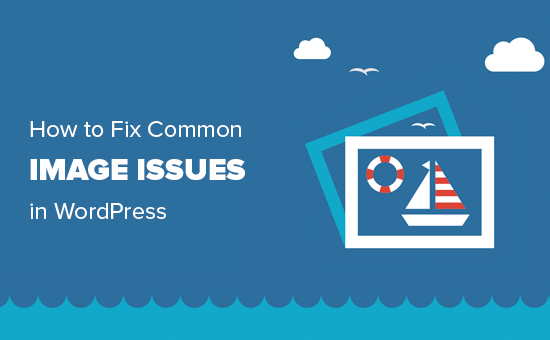
Dado que se trata de un artículo detallado, aquí tiene la lista de los problemas / conflictos / incidencias relacionados con las imágenes que trataremos en este artículo. Puede utilizar estos enlaces rápidos para omitir un determinado debate:
- How to Upload Images in WordPress
- How to Align an Image to the Left or Right in WordPress
- How to Add Captions Below Images
- How to Display Photos in Columns and Rows
- How to Create Responsive Image Galleries in WordPress
- How to Fix Missing Post Thumbnails / Featured Image
- How to Add Cover Images in WordPress Posts and Pages
- How to Fix the Featured Image Appearing Twice Issue
- How to Crop Images in WordPress
- How to Add a Header Image in WordPress
- How to Add a Background Image in WordPress
- How to Find Free Images for Your WordPress Blog Posts
- How to Tag Images in WordPress
- How to Import External Images in WordPress
- How to Require Featured Images for Posts in WordPress
- How to Set a Default Featured Image in WordPress
- How to Create Additional Image Sizes in WordPress
- How to Prevent Image Theft in WordPress
Cómo subir imágenes en WordPress
WordPress facilita enormemente la subida de imágenes a tus entradas, páginas y zonas sin contenido, como las barras laterales.
Para subir imágenes en entradas y páginas de WordPress, sólo tiene que añadir el bloque Imagen al editor de contenido.
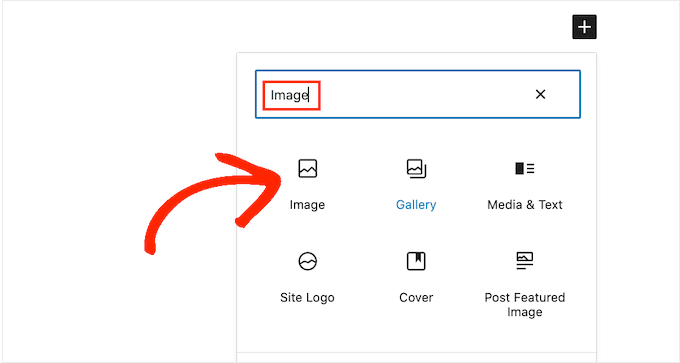
También puede añadir el bloque Imagen simplemente escribiendo /image en un bloque Párrafo.
El editor empezará a mostrar bloques que puedes insertar en cuanto empieces a escribir.
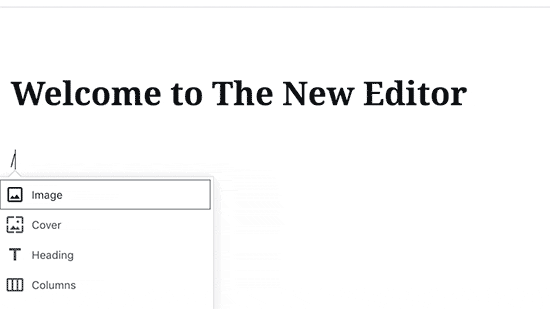
Ahora WordPress añadirá el bloque Imagen al editor.
Debe hacer clic en el botón “Subir” para seleccionar y subir la imagen desde su ordenador.
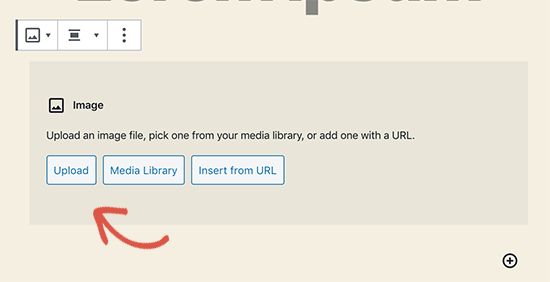
También puede seleccionar una imagen subida anteriormente desde su biblioteca de medios.
Después de subir la imagen, verá una vista previa en directo de la imagen en el editor de contenido.
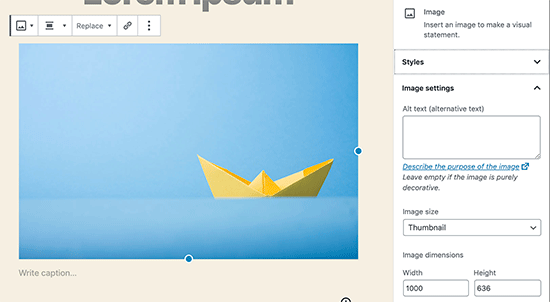
También verás ajustes de imagen en el panel derecho. Desde allí, puede proporcionar el texto alternativo de la imagen, seleccionar el tamaño de la imagen y personalizar el estilo de la imagen.
Cómo alinear una imagen a la izquierda o a la derecha en WordPress
Con WordPress, alinear imágenes a la izquierda, a la derecha o al centro es fácil. Basta con seleccionar la imagen al hacer clic sobre ella y, a continuación, hacer clic en el botón de alineación de la barra de herramientas de bloque.
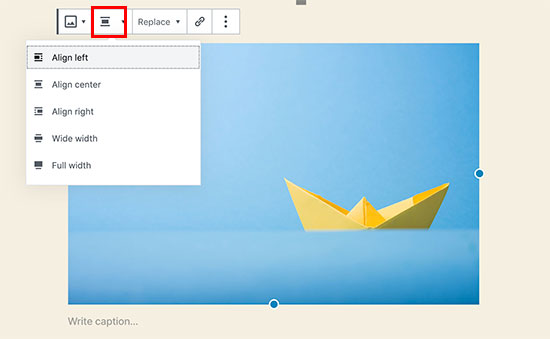
Es posible que haya advertido que algunos blogs populares de WordPress utilizan imágenes rodeadas de texto.
Para ello se utiliza la característica de alineación.
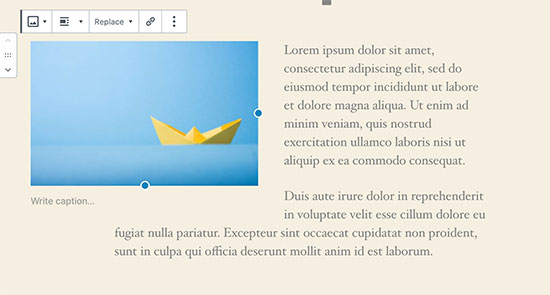
También puede utilizar el bloque Medios y texto en lugar del bloque Imagen.
Este bloque está hecho específicamente para añadir imágenes a continuación del texto.
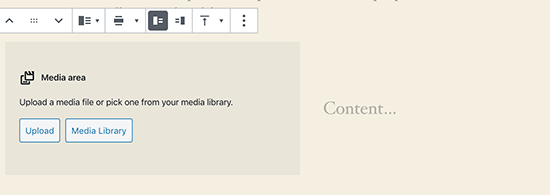
A continuación, puedes subir una imagen y un texto uno al lado del otro.
También puede utilizar la barra de herramientas de bloque para cambiar el lado de la imagen o del texto.

Para una guía detallada, puede comprobar nuestra guía sobre cómo alinear imágenes utilizando el editor de bloques de WordPress.
Cómo añadir leyendas debajo de las imágenes
WordPress te permite añadir fácilmente leyendas a las imágenes. Después de subir una imagen, verá la opción de añadir una leyenda justo debajo de la vista previa de la imagen.
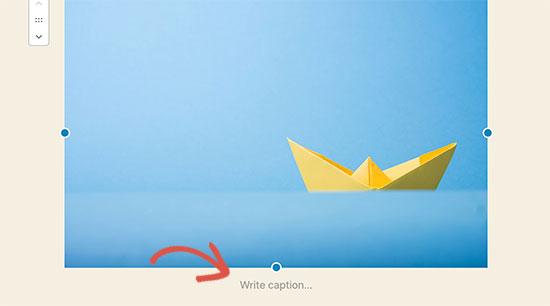
Del mismo modo, también puede añadir leyendas a las galerías de imágenes en WordPress. Para más detalles, consulte nuestra guía sobre cómo añadir leyendas a las imágenes en WordPress.
Cómo mostrar fotos en columnas y filas
A menudo, los usuarios nos preguntan cómo mostrar ordenadamente las fotos en columnas y filas.
Supongamos que quieres compartir fotos de una fiesta de cumpleaños o de las vacaciones. Puedes añadirlas una a una en una entrada, pero parecerá una larga lista de imágenes.
La mejor forma de agrupar tus fotos es creando galerías de imágenes.
WordPress incorpora un bloque Galería que permite añadir fácilmente imágenes en filas y columnas con vistas previas en miniatura.
Sólo tiene que añadir el bloque Galería al editor de entradas y seleccionar las imágenes que desea subir.
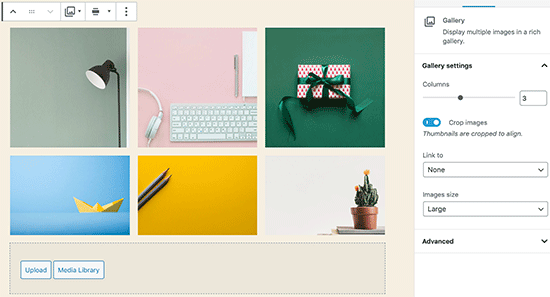
Para obtener instrucciones más detalladas, consulte nuestra guía sobre cómo crear una galería de imágenes en WordPress.
Cómo crear galerías de imágenes adaptables en WordPress
Usted notará que las galerías de imágenes por defecto de WordPress carecen de varias características. Por ejemplo, tampoco son muy fáciles de navegar.
Si suele subir imágenes y fotografías a su sitio de WordPress, entonces necesitará un plugin de WordPress para galerías de fotos.
Le recomendamos que utilice Envira Gallery. Le permite crear fácilmente galerías de imágenes hermosas y totalmente adaptadas a dispositivos móviles en su sitio de WordPress.
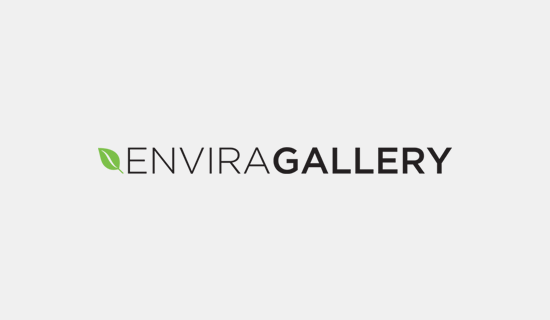
Lo mejor es que añade funciones adicionales como álbumes, plantillas de galerías, uso compartido en redes sociales, pases de diapositivas, marcas de agua, paginación, protección por contraseña, etiquetado, vista a pantalla completa y mucho más.
Otro popular plugin de WordPress para galerías de fotos es NextGEN Gallery. Ofrece muchos diseños de galería y una hermosa caja de luz galería para mostrar imágenes en WordPress.
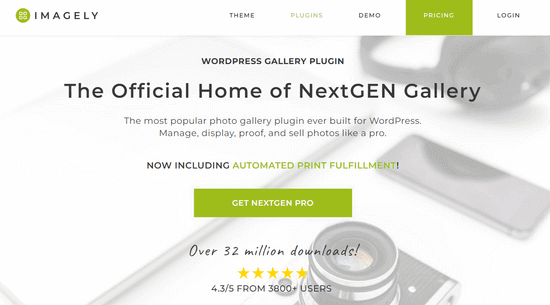
NextGEN Gallery también incluye potentes características para fotógrafos profesionales como pruebas de fotos, realización de impresiones, protección de imágenes, extensión para Adobe Lightroom, pasarelas de pago de PayPal y Stripe, y mucho más.
Cómo corregir la falta de miniaturas de entradas / imagen destacada
La mayoría de los temas de WordPress te permiten mostrar una imagen destacada con tus artículos. Veamos cómo establecer una imagen destacada en WordPress para evitar que falten miniaturas.
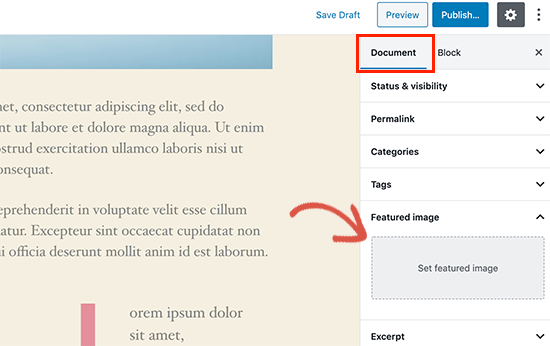
En primer lugar, tienes que hacer clic en “Establecer imagen destacada” para subir la miniatura de tu entrada.
Después de subir la imagen, podrás ver la miniatura de tu entrada en la caja meta de imágenes destacadas, de la siguiente manera.
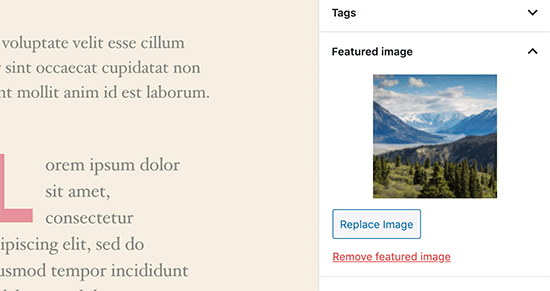
Para más detalles, consulte nuestra guía sobre cómo añadir una imagen destacada o una miniatura de entrada en WordPress.
Cómo añadir imágenes de portada en entradas y páginas de WordPress
Las imágenes de portada son imágenes anchas o de ancho completo que pueden utilizarse como separador entre las distintas secciones de un artículo o una página de ofertas extensa.
Son muy atractivos y ayudan a los usuarios a explorar fácilmente una página sin sentirse abrumados por demasiado texto.
Para añadir una imagen de portada, basta con añadir el bloque Portada al editor de contenido.
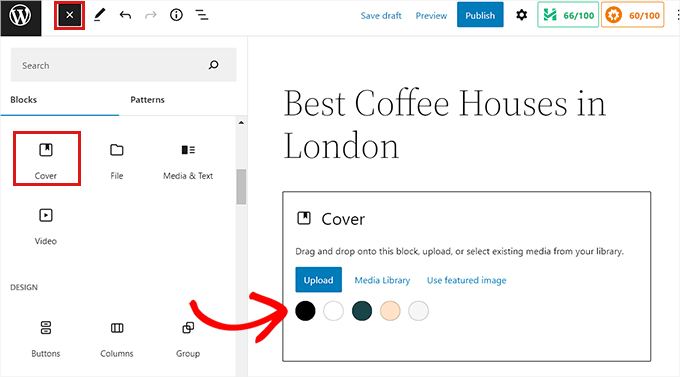
A continuación, deberá subir la imagen que desee utilizar desde su ordenador o seleccionar una de la biblioteca de medios. Si no desea utilizar una imagen, también puede seleccionar un fondo de color como portada.
Consejo: Es mejor utilizar una imagen grande para obtener un mejor resultado.
Ahora verás una vista previa de tu imagen de portada en el editor. Puede cambiar las opciones de visualización de la imagen de portada desde la barra de herramientas del bloque o utilizar los ajustes de la derecha.
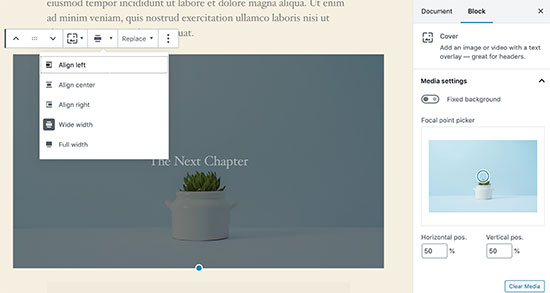
Para obtener más información, consulte nuestra guía sobre la diferencia entre imagen de portada e imagen destacada en WordPress y cómo utilizarlas de forma eficaz.
Cómo corregir el problema de la imagen destacada que aparece dos veces
Insertar la imagen destacada dentro del contenido es un error común que cometen los principiantes.
Una vez establecida la imagen destacada, no es necesario insertarla en la entrada junto con el contenido.
Si lo haces, la imagen destacada aparecerá dos veces. Una como imagen destacada y otra como imagen dentro de la entrada.
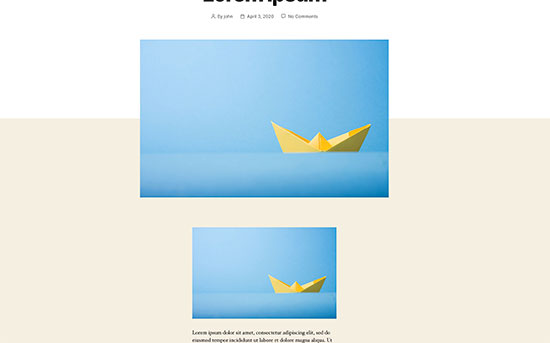
Puedes añadir otras imágenes dentro de tu entrada, pero tu imagen destacada va en el cuadro de imagen destacada.
Para más detalles, consulte nuestra guía sobre cómo corregir las imágenes destacadas que aparecen dos veces en las entradas de WordPress.
Cómo recortar imágenes en WordPress
Cuando subes imágenes desde tu teléfono o cámara, suelen ser demasiado grandes.
WordPress crea automáticamente tamaños de imagen pequeños, medianos y grandes para tu subida original. Pero a veces, es posible que necesite recortar la imagen en un tamaño diferente.
WordPress no es Photoshop, pero incluye algunas características básicas de edición de imágenes, como escalar, recortar, voltear y rotar imágenes.
Simplemente vaya a Medios ” Añadir nuevo y suba su imagen. Después de subir la imagen, verá un enlace “Editar” junto a la imagen subida.
Al hacer clic se abrirá la pantalla Editar medios, donde verá un botón ‘Editar imagen’ justo debajo de la imagen. Esto abrirá el editor de imágenes de WordPress.

Desde aquí, puedes hacer clic en el botón “Editar imagen” situado debajo de la vista previa de la imagen. Se abrirá la pantalla de edición de imágenes.
En la pantalla del editor de imágenes, verás botones para realizar algunas tareas básicas de edición de imágenes, como recortar, girar, cambiar el tamaño, etc.
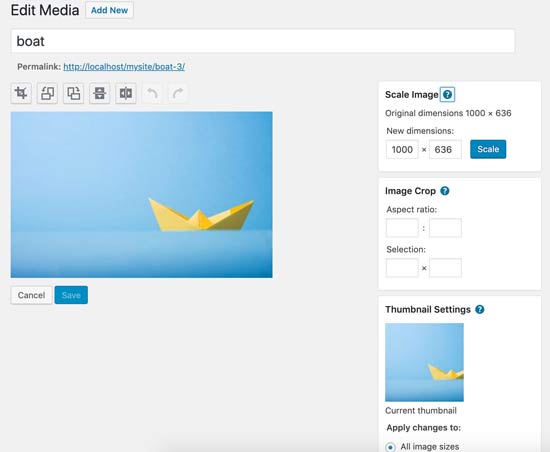
Si utilizas el editor de bloques, puedes recortar imágenes utilizando la característica de recorte incorporada en la barra de herramientas de imagen.
Basta con hacer clic en un bloque de imagen y seleccionar el icono “Recortar” de la barra de herramientas.
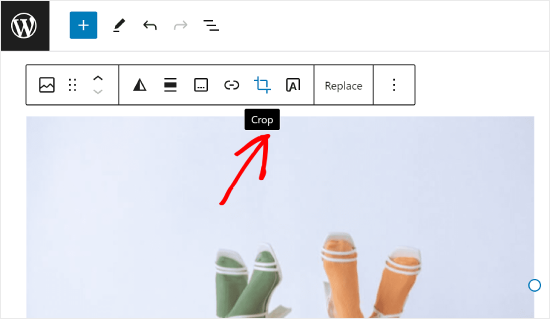
Después, puedes ajustar la relación de aspecto de la imagen y el área recortada de la misma según tus preferencias.
Puedes usar tu relación de aspecto original o una predefinida por WordPress.
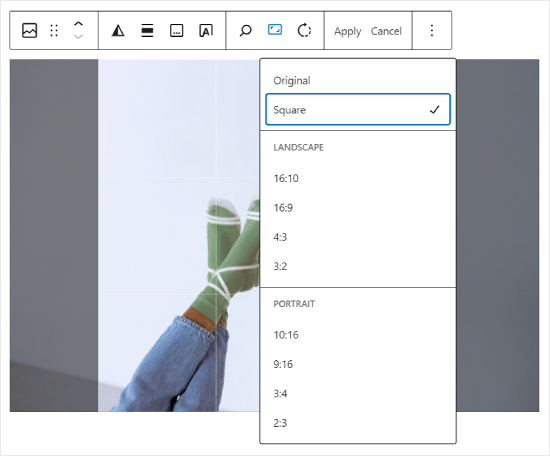
Para obtener instrucciones más detalladas, consulte nuestra guía sobre cómo recortar, rotar, escalar y voltear imágenes en WordPress.
Cómo añadir una imagen de cabecera en WordPress
Una imagen de cabecera en WordPress es una característica del tema. Muchos temas gratuitos y premium de WordPress son compatibles con / dar soporte a las imágenes de cabecera.
Algunos temas de WordPress permiten establecer una imagen de cabecera para todo el sitio, mientras que otros solo permiten establecer una imagen de cabecera para la página de inicio.
Puedes subir tu propia imagen de cabecera personalizada desde la página Apariencia ” Personalizar.
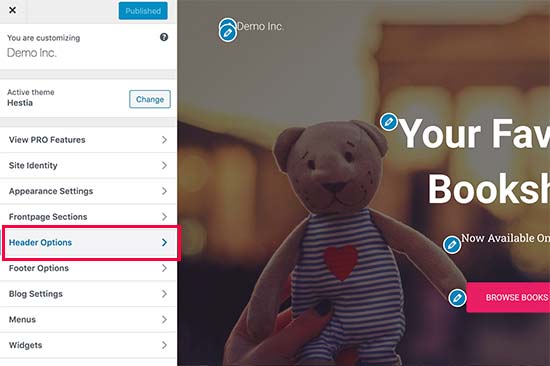
Si utiliza un tema Block, la ubicación para editar la cabecera de su tema es diferente.
En primer lugar, tienes que ir a Apariencia ” Editor.
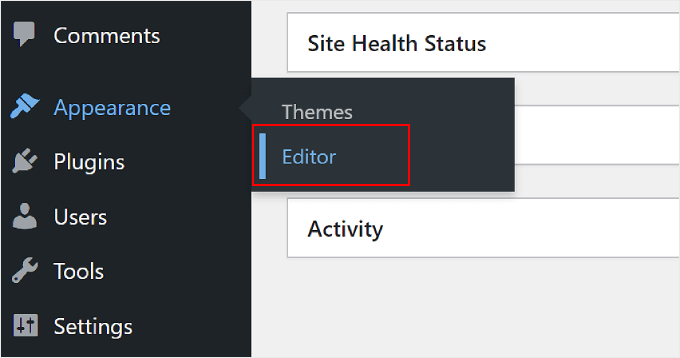
A continuación, selecciona “Patrones”.
Esto le llevará a una página donde podrá acceder al patrón de cabecera de su tema.
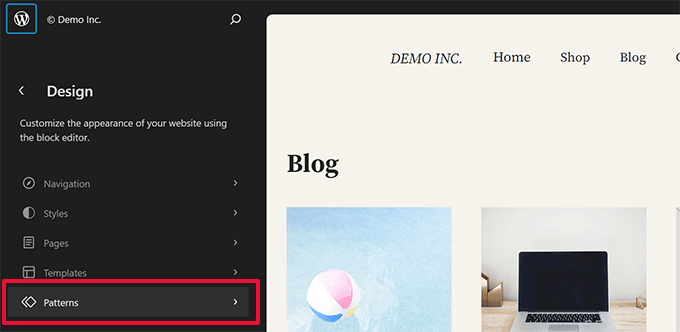
A continuación, desplácese hasta la sección Piezas de plantilla.
Una vez hecho esto, sólo tienes que seleccionar “Cabecera” y hacer clic en la plantilla de cabecera para editarla.
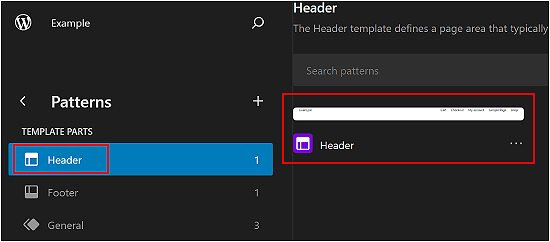
A partir de ahí, puede añadir un bloque de imagen al patrón de cabecera como lo haría en la primera sección de este artículo.
Cómo añadir una imagen de fondo en WordPress
Al igual que la imagen de cabecera personalizada, una imagen de fondo personalizada también es una característica de los temas de WordPress. Muchos temas de WordPress vienen con soporte para imágenes de fondo personalizadas.
Visita Apariencia ” Personalizar para iniciar el Personalizador de temas. Si puede ver la opción Imagen de fondo, significa que su tema es compatible con fondos personalizados.
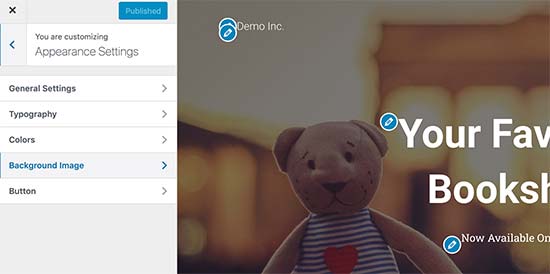
Es una característica del tema, por lo que varía de un tema a otro. Dependiendo de tu tema, verás diferentes opciones para dar estilo a tu imagen de fondo.
Si tu tema no es compatible con una imagen de fondo, puedes utilizar un plugin para añadir imágenes de fondo a pantalla completa a tu sitio web.
Cómo encontrar imágenes gratuitas para tus entradas de blog en WordPress
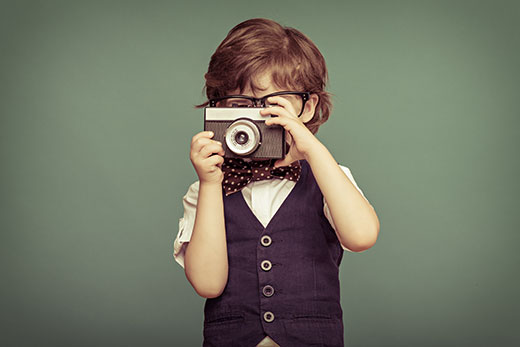
Las imágenes pueden hacer que tus artículos destaquen. Sin embargo, debes respetar los derechos de copyright de otras personas y encontrar imágenes que puedas utilizar legalmente.
Nuestros lectores nos preguntan a menudo acerca de cómo encontrar las mejores imágenes libres de derechos para utilizar en sus entradas.
Hay muchos sitios web donde puedes encontrar imágenes gratuitas. Sin embargo, pronto advertirá que las imágenes de esos sitios parecen sobreutilizadas y genéricas.
Consulta nuestro anuncio / catálogo / ficha de las mejores fuentes de imágenes gratuitas de dominio público y con licencia CC0 en Internet.
Cómo etiquetar imágenes en WordPress
Si tienes un blog de fotografía, habrás advertido que WordPress no te permite ordenar fotos e imágenes.
¿No sería estupendo poder añadir etiquetas a tus imágenes para que tú y tus usuarios podáis explorarlas fácilmente?
Por suerte, hay algunos plugins que te permiten hacer precisamente eso.
Para un blog relacionado con la fotografía, la mejor opción es utilizar Envira Gallery, que viene con una extensión para añadir etiquetas.
Envira Gallery le permite crear hermosas galerías de fotos listas para móviles en WordPress. Mediante el uso de etiquetas, los usuarios pueden filtrar y ordenar fácilmente las fotos sin necesidad de recargar la página.
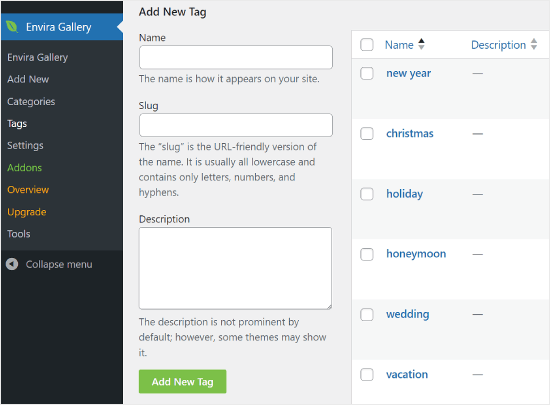
Para más detalles, consulte nuestro artículo sobre cómo añadir categorías y etiquetas a la biblioteca de medios de WordPress.
Cómo importar imágenes externas en WordPress
Esta pregunta se plantea a menudo cuando se está migrando un sitio a WordPress. Es posible que algunas imágenes de su sitio web sigan apuntando a una ubicación antigua.
Esto es especialmente cierto para los usuarios que importan blogs de Blogger, Squarespace o WordPress.com.
Aunque las imágenes de su sitio aparezcan correctamente, siguen cargándose desde una fuente externa. Para resolver este problema, todo lo que necesitas hacer es instalar y activar el plugin Auto Upload Images.
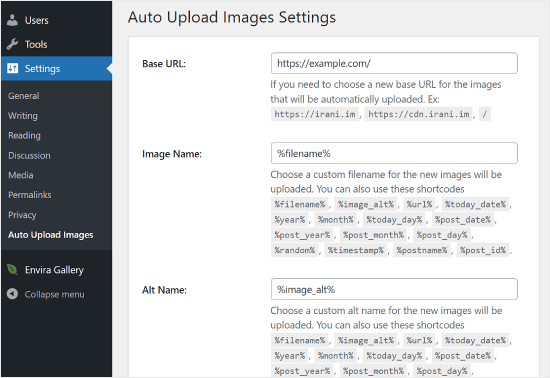
El plugin comprobará si hay imágenes externas una vez que actualices o guardes cualquier entrada o página. Puede hacerlo manualmente para cada entrada o página, o puede editar por lotes todas las entradas y simplemente hacer clic en el botón de actualización.
Para obtener instrucciones detalladas, consulte nuestra guía sobre cómo importar imágenes externas en WordPress.
Cómo Requerir Imágenes Destacadas para Entradas en WordPress
Si tiene un sitio con varios autores en WordPress, es posible que algunos de ellos no estén familiarizados con la función de imágenes destacadas.
En este caso, es posible que desee recordar a usted mismo o a sus usuarios que suban una imagen destacada cada vez que envíen una entrada en WordPress.
Puede hacerlo instalando y activando el plugin PublishPress Checklists.
Una vez activado, el plugin mostrará un signo de exclamación rojo y una pestaña Checklist informando a los usuarios de que esta entrada requiere una imagen destacada.
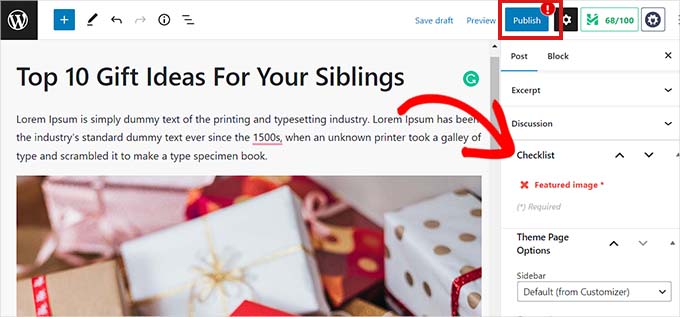
Tú y tus usuarios podréis guardar entradas como borradores, pero no podréis publicar la entrada hasta que añadáis una imagen destacada.
Consulte nuestro artículo sobre cómo exigir imágenes destacadas para entradas en WordPress para obtener más instrucciones.
Cómo establecer una imagen destacada por defecto en WordPress
Encontrar la imagen destacada perfecta para cada entrada o artículo es una tarea difícil. A veces, es posible que no desee añadir una imagen destacada a una entrada, pero su tema puede parecer torpe sin uno.
Aquí es donde una imagen destacada por defecto puede ser útil. Una imagen destacada por defecto se utiliza cuando un artículo no tiene una imagen destacada propia.
Puedes establecer una imagen destacada por defecto utilizando el plugin Imagen destacada por defecto.
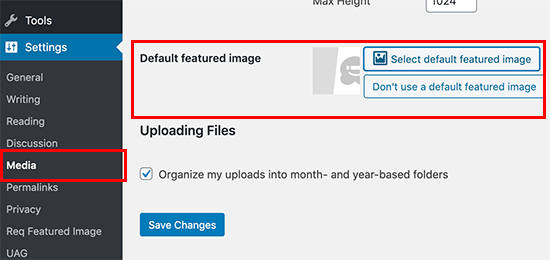
Para más instrucciones, consulte nuestra guía sobre cómo establecer una imagen destacada por defecto en WordPress.
Cómo crear tamaños de imagen adicionales en WordPress
Por defecto, WordPress crea y ahorra diferentes tamaños de las imágenes subidas, incluyendo miniaturas. Es posible que tu tema de WordPress también genere diferentes tamaños de imagen.
Si desea crear tamaños de imagen adicionales para su sitio web WordPress, deberá registrarlos añadiendo código personalizado al archivo functions.php de su tema.
Para obtener más información, consulte nuestra guía sobre cómo crear tamaños de imagen adicionales en WordPress.
Cómo evitar el robo de imágenes en WordPress
A veces, los usuarios pueden robar imágenes de su sitio web WordPress para utilizarlas en sus propios sitios. Esto puede ser muy frustrante, sobre todo si haces tus propias fotos o creas tus propios gráficos.
Por suerte, puedes evitar el robo de imágenes desactivando el botón derecho del ratón, añadiendo una marca de agua a tus imágenes, desactivando los enlaces directos y añadiendo avisos de copyright.
Para obtener más información, consulte nuestra guía sobre cómo evitar el robo de imágenes en WordPress.
Esperamos que este artículo te haya ayudado a corregir algunos de los problemas de imagen más comunes en WordPress. Puede que también quieras ver nuestra lista de los errores más comunes de WordPress y cómo corregirlos y nuestras selecciones de expertos de los mejores plugins de WordPress para hacer crecer tu sitio.
If you liked this article, then please subscribe to our YouTube Channel for WordPress video tutorials. You can also find us on Twitter and Facebook.





Syed Balkhi says
Hey WPBeginner readers,
Did you know you can win exciting prizes by commenting on WPBeginner?
Every month, our top blog commenters will win HUGE rewards, including premium WordPress plugin licenses and cash prizes.
You can get more details about the contest from here.
Start sharing your thoughts below to stand a chance to win!
dannielle says
Help I had a background image and for some reason its gone. I have tried reassigning it, re-uploading it, and changing the image all together. I have even tried changing my theme and nothing works it doesnt show. Thanks in advance for any help you can give me
george says
Need help. I’m using Seos Music theme and all my posts that get published on my primary page are automatically aligned to the right. In the archive pages its correctly aligned. According to seos music theme it shouldn’t be doing this but I probably added a plugin for something else and it ruined this. Do you know which classes to look for to fix this issue if you ever heard of this happening?
Neil says
To fix the hhtp error when uploading images I tried loads of fixes listed on various websites, however the fix that worked for me was to add a line of code to the .htaccess file to modify the PHP version being used.
The default our web hosting provider was using 5.5, but 5.6 and 7.0 can also be specified.
Adding the following line of code to the .htaccess file cured the image upload issue for me on various sites.
AddHandler application/x-httpd-php56 .php
(Note the gap before .php should be left exactly as shown)
For 7.0 it would be:
AddHandler application/x-httpd-php70 .php
Your web hosting provider should be able to advise you what versions of PHP they support.
sandra says
hi, I see many helpful tips in your article, however I can’t use them because somehow I do not seem to get an editing screen like yours. Mine does not have any buttons for cropping, scaling or mirroring and things like that. Do you know what I am doing wrong?
Mark says
Thank you for a great article.
I would like to know how can I optimize my wordpress webpage by taking into consideration sizes of the images to load.
What is really strange is the fact that my full webpage is loading much faster (it has almost half of the size as my mobile version). In fact, I can observe that wordpress tries to download bigger image files for my mobile version that for the full webpage.
I have tried to force images to have “medium” size, but nonetheless they are not loading this way on mobile (it was tester in network tab in dev tools).
Just to add, I have tried to minimize my images in various ways. I upload 1200 x 900 image and then it is resized by wordpress. Somehow, wordpress forces to load bigger images than needed – sometimes it is loading full image and sometimes in the resolution belonging to “medium-large” size.
What is really strange is the fact that when wordpress processes my 1200 x 900 image it produces another image with the same resolution that is bigger than my initial file.
Could you please let me know what is the best way of dealing with the problem described?
Kristen says
Hello-
this site is absolutely amazing!! thank you for all the valuable inside.
i had a question about my header. I have a not so wonderful premium theme. I added the image to my site, but it only appears on the left corner on a laptop browser. I looks perfect on my iPad though. Anyone one else experience or have any advise? thanks
Michael says
Hi I wondering, I can not insert photos with this add media button. Even I click on it nothing happen.
Natasha says
Why is it not possible to change the feature image after published?
WPBeginner Support says
Hi Natasha,
You can easily change featured image by editing a post. Scroll down to featured image box and then click on the remove featured image link.
Administrador
Radu says
Hi,
I have the following problem listed below.
When I select a photo to integrate in my post as a featured image, it displays ok within the home page and also in my post page however when i try to edit my image like cropping/rotating/mirroring etc. the image is not shown. The link of the image is broken it appears.
Could you advise, please ?
bec says
Very helpful article thanks.
Can you tell me why some images that I have added into my posts appear to ‘move’ when hovered over yet others do not? I love the look of this and would like it to happen consistently across my images.
A pdf version of this would be awesome!
Jaclyn says
Good article, but the problem I’m having is I edited a picture using picmonkey and used that as my featured image and now, at the top of my post, the featured image is left-aligned. How do I fix that??? There are no options for alignment (or much else) on featured images.
Shan says
Hi,
m using the twenty sixteen child theme and I’m working on speeding up my loading time. I used pingdom for the speed check. My home page came out as the third biggest file while the page only contains 1 image of 600 x 400 and my other pages got sliders with more than 10 images. So I dont understand why the file size of my homepage is so big. And how I should ajdust this. I have inserted the image with insert media and not with a featured image. Not sure what the difference is. But when I use featured images the file will become even bigger.
Hopefully you can help me out on this.
Hazy
bala krishna says
i have used your ewww optimizer to optimize images it did a great work on it but as soon as it is done some fatal error occured and some background scripting is going on which gets me internal server error ..when i contacted my host administrators they said some png images are causing this problem ..i analyzed it in gmetrix and i got this as errors under leverage cached browsing my website is entirely down now please help
bala krishna says
and to add to that issues they said these process are constantly running even after killing them screen shot is posted please help me solve this
Mark Simpson says
I have a problem that when I upload and publish an image in our blog, it shows differently on the web vs mobile device. It will be upside on web, but rightside up on mobile. Any ideas? Anyone else see this problem?
Pia Leinonen says
Hi! Somehow the insert as a thumbnail and link to the original file – options have disappeared from my wordpress site when adding a new picture. How can I fix this? The theme I use is called Matala. Could you help me?
Dilchan says
I want to make a video streaming website like netflix. I mean same to same can i make with wordpress
Patricia Viscount says
That was very helpful, thanks. I’ve mostly learned most of these things by trial and error, so I’m glad you gave me more information… The one thing I can’t seem to figure out is how to know when (and fix!) photos appear upside down. They look fine to me as the author but I’ll get comments from readers about them being upside down. Help please!
WPBeginner Support says
Please see our guide on how to fix upside down or flipped images in WordPress.
Administrador
Banna says
Most of the links in top show me a 404 page.
Please check.
rad says
Hi
When I add one image(929×400) to post there is not problem,
but when I want to Putting Multiple Images(452×400) On One Line,its appear column,and I cant put it on one line,while there is enough width for putting.
(2×452<929).what is problem?
thanks
Columbus says
Hi I am have problem of with my site how can I stop to see my post image and my features image appearing in home page and also how to stop situation I upload a video on my site and upload features image appearing my phone. What is the solution to these problem of video and features imgaes appearing in features image please help taken and cause
Todd McCann says
Thanks for a great article. My featured images have captions, but they don’t show up in the post. I don’t care that much, but I thought we were supposed to give credit to the photographer and link to the creative commons license to be legal?
WPBeginner Support says
You can add a plain link below the photograph or at the end of your posts.
Administrador
Suman Gayen says
Hello!
The images in my blog are showing little cropped up. But in internet explorer it is showing correct. What should i do? Please suggest.
Pelwal says
Hello can you help me check up on my website, Both featured image and images inside post are not showing.
Anca says
I started my blog recently and this was very helpful.Thank you so much!
Rasaq says
Please, images are showing up on my blog posts. I use same theme and settings on another blog and they are working fine. Help me.
Annette Osterlund says
I am creating images for someone else who is placing them in wp. They have pictures and text. I use InDesign to arrange things and have saved the image as a jpeg. The type appears all blurry and bitmapped no matter how large I make the document. (4200 x 4800 pixels). What is the best way to create/save images?
Imaneula Bright says
In the last 2 weeks, all the image in the media library stopped showing. i suspect something changed the file format. pls what can i do?
WPBeginner Support says
Check file permissions.
Administrador
Sam Meaghan says
Hello,
This article is actually really handy. Just I need to know how to set a default featured image for my homepage on wordpress.com. I have a feature set as the front page, and have tried to change the featured image to the logo. Rather oddly, as it is a feature that changes weekly, it only ever comes up with the week before’s content.
Could you help me? I’m going crazy over here
WPBeginner Support says
Please see our guide on the difference between self hosted WordPress.org vs free WordPress.com blog.
Administrador
Miz Akwele says
this post is pretty resourceful for beginners, BUT my problem is with uploading media on the backend. For several hours I’ve been frustrated with this issue – it’s just not working.
Initially, I thought it was the size of the images, but miraculously, 2 bigger sizes as compared to the others I’ve been trying to upload, have been successful. Then I figured it could be the resolution, but that’s also not the issue.
I keep receiving the HTTP ERROR notification after a slow process.
What am I not doing right? What do I do about this? I need help urgently. Thanks a million.
Grace Ashama says
Were you able to fix this eventually? How did you do it please? I’m having the same problem as well
Larry Cross says
Featured images in posts are not visible on cell phones and tablets. They look fine on desktops. Problem started after updating WP and Enfold theme.
WPBeginner Support says
Please contact your theme developer for support, they will be able to help you better.
Administrador
Courtney jones says
I am not able to see my features images or header images on my mobile device anymore. Nor is the contact form showing up these things are very important as to most of my viewers will be on cell phone or iPad. What could be the issue?
Rose says
Hi there,
Great post but I still can’t find my issue and have looked and looked. I have a website and have only just noticed that when i go to my posts if i click on the image is shows a very large photo. usually on its own and i have to click back to remove seeing it. Can you help me undersand what setting i need to do so that the photo becomes sticky I guess and not an active large photo.
I have wp smushit to reduce image size and have check page load and it appears it is the images as the main culprit.
Many thanks Help !!
WPBeginner Support says
When you add an image into WordPress, you have the option to choose the size of image and whether or not it should be linked.
It seems that you have set it to link to image file. It also seems that you upload large image files. To stop WordPress from automatically linking see our guide on how to automatically remove default image links in WordPress.
Administrador
MIREL says
Don’t know how to get my wp content and its giving me a lot of difficulty to rectify my “featured image writing fail to write file to hard disk”.
Christine says
We created a Photo Gallery using WordPress. When I first go to the Photo Gallery page, a blue box pops up for a second and then disappears. It has blue lines, and each line has a number before it, 1, 2, 3, etc. Perhaps the number of images? Not sure. The developer who created our web site says he can’t figure out why its doing this. It happens on all the PCs in our office, and mobile devices. Anyone ever see this or have any answers on how to fix this annoying problem? It causes a delay in downloading our photo gallery. Thank you.
WPBeginner Support says
This issue can be caused by conflicting or broken CSS. Go to your plugin’s page and deactivate all your plugins. Visit your website after deactivating each plugin until you find the culprit. If you don’t find any plugin causing the issue, then you can safely activate the plugins you deactivated earlier. Try temporarily switching to a default WordPress theme, like Twenty Sixteen to find out if the issue is caused by your WordPress theme.
Administrador
Susan Rawlings says
Hello,
All of the images in my posts are showing as thumbnails. I think somehow the Gallery was activated, but the blog owner does not want the images to show in the black pop up box that currently appears when you click on an image in a post. When I am in a published post now, for example, I click on a thumbnail. The thumbnail pops open a black box, inside of which you can scroll through and see all of the images inside of the post by clicking arrows back and forth. How do I return the posts to showing images without being inside the gallery? The images themselves need to open in a new tab or window, one that is linked through Google Drive. I cannot figure this out. Help!
Thanks in advance…..
WPBeginner Support says
When adding an image to a post, after uploading the image you can see some options in the right hand column. One of the option is to select the image size to add and how you want image to be linked. If this does not help, then deactivate all your plugins. See if this resolves the issue. If it does, then reactivate plugins one by one. After activating each plugin visit your site to see if the problem came back. Do that until you find the plugin that is causing the issue.
Administrador
Jabr says
Hello wpbeginner,
First of all, allow me to thank you very much for your great efforts. I have a them which has a featured image to add. I was uploading the images to external website and then copy the image url and paste it in the featured image and it worked perfect. Now I want to change the theme, the images which are uploaded on the website are shown perfectly but the images which were uploaded on external website are not shown. So what to do in order to fix this? I don’t want to go again for the 1000 posts I have and add the images manually so that appear in the new theme. Is there an automatic way to do this?
STA says
I have created a popup with this plug in, but it does not automatically pop up every hour like it is supposed to, and it doesn’t respect any formatting changes I make to the popup itself. Can anyone help me?
Roxana Dell'Osso says
HI,
I need your help so badly. To start I am not a tech person, but I do have my website and blog with wordpress.
I have written several articles for my blog and never had this issue with the images that I am including as part of the blog.
I uploaded all the images very nicely no issues there. The problem starts when I preview the post prior to approving. The images (pictures) look cut, but in the back the post and images look perfect. I don’t know what to do – I have read most of the articles but it is hard to figure out what to do when you actually don’t know what to look for. Could you please help me…..
Roxana.
Rebecca says
I am trying to upload images to the media library and continue to get this error
“Cycle YP single page.jpg” has failed to upload due to an error
Missing a temporary folder.
Any idea what temporary file?
i am VERY new to this, we had this set up for us and I have no idea how to fix this issue – any advice will be gratefully received
WPBeginner Support says
Please contact your web host. It seems that the temporary folder used by PHP to store uploads is not accessible by the server.
Administrador
Steve Kohn says
I found this page looking for guidance on rotating header images, but learned so much more. Many thanks. I’ll be coming back here often.
Crystal Merrill says
My wp has suddenly stopped rotating images. Photos look fine in the draft section and in the media library – rotated correctly but in the “view post” or on my website on pc or mobile, photos are rotated incorrectly. Please help!
Margie says
Can anyone explain why , when posted, my photos have a huge space under them before the next row of text? I do not want the text wrapped around my photo. I insert image, make it the size I want and then continue with text, but when posted they show with a huge empty space. Thanks
Karen Molenaar Terrell says
I’m trying to put a new image in my header. I’ve never had problems with this before, but this time every image I upload comes up as a teensy tiny little box in the upper left hand corner. I finally pushed “crop and publish” thinking maybe the image would magically appear once I’d done that, but nope. Now I have no image at all. Then I thought maybe it was my computer, so I used my husband’s computer and had the same problem-o. Help?
Tawny says
I am managing a website for a business and we have an employee page. All but one of the employee pages are perfect. We have it so the image is left aligned and there is text wrapped around it, however for this trouble page the text is butt up to the image and it looks sloppy but when I try to add indents it doesn’t work. How do I solve this?
Tom says
Try adding margins to the tag. You may have to play around with the 4 values for margins (top, right,bottom,left).
style=”float: left; margin: 40px 10px 0px 20px;”
Tom says
Add the style to the img tag.
Shell says
How can you remove the link to all past uploaded images so al images link to “none”?
WPBeginner Support says
Please see How to Automatically Remove Default Image Links in WordPress
Administrador
Chrisray says
Bravo!!! This post has really helped today! Thank you very much.
Camilla says
How do I ensure that images in my blog posts that other people see in their reader come up as their original size that they appear on my website, and aren’t simply reduced down to a degrading thumbnail? Thanks a lot
John says
Did you ever get an answer to your question, or figure it out? I am new to WP and I am having the same issue you described. I see my image fine on one of my computers, but it appears as a thumbnail on my other computer.Do you know how to fix this? Thanks a lot.
opine says
I moved wp to a new folder. now my images dont show up in posts… how do I fix this? images are in the library but not showing.
Hans G N Andersen says
Hi, what about this issue: howo to make text wrap around images also in the RSS feed? in feed readers, the text comes below the image – how to fix that? cheers
Badani says
Hi, very helpful article.
However, I am trying to see if there is a way to fix the alt text from getting cut off when the image is clicked on and pops up. The text below the image in the lightbox pop-up is the alt text, but if it is too long, it will not text wrap. It is in the Customizr theme.
Is there anything I can do about this? Thanks!
Amoy Nicholson says
I keep getting an error that my images cannot resized when using the cropping option. How do I fix that?